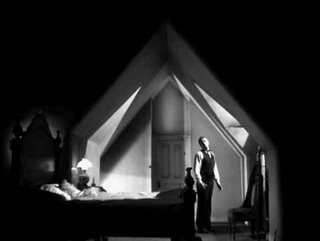Hunted
 After missing countless revival screenings and allowing sufficient dust to accumulate on the "must see" list, I finally rented The Night Of The Hunter. It's kind of inadvertently been Robert Mitchum week at my house. First, for the sake of von Sternberg, I watched him romantically play off of Jane Russell in Macao and, for Nicholas Ray, I saw him sauce it up with Susan Hayward in The Lusty Men. Of course here, he is decidedly less friendly. As a creepy killer preacher with Love and Hate tattooed on his fingers, Robert Mitchum seems as flawlessly at home as he does camping it up with Russell. In fact, all of the performances in The Night of the Hunter are relatively seamless - even Lillian Gish! I know!
After missing countless revival screenings and allowing sufficient dust to accumulate on the "must see" list, I finally rented The Night Of The Hunter. It's kind of inadvertently been Robert Mitchum week at my house. First, for the sake of von Sternberg, I watched him romantically play off of Jane Russell in Macao and, for Nicholas Ray, I saw him sauce it up with Susan Hayward in The Lusty Men. Of course here, he is decidedly less friendly. As a creepy killer preacher with Love and Hate tattooed on his fingers, Robert Mitchum seems as flawlessly at home as he does camping it up with Russell. In fact, all of the performances in The Night of the Hunter are relatively seamless - even Lillian Gish! I know!
 Performances aside, I think the real deal here is the positively immaculate look of the film. Every single second of the Hunter is beautifully composed. Shot on a lavish UA sound stage, every moment leaks glorious artificiality, magnificently arranged light spilling over every board and fake brook. To heighten the beautifully ersatz facade, real creatures of nature (aside from the child actors, of course) are posited among the plasticine shrubbery. Frogs croaks and foxes bark in trees so idyllic they can only be fake. It's the sort of heightened serenity which can be found in the glorious films of the fifties.
Performances aside, I think the real deal here is the positively immaculate look of the film. Every single second of the Hunter is beautifully composed. Shot on a lavish UA sound stage, every moment leaks glorious artificiality, magnificently arranged light spilling over every board and fake brook. To heighten the beautifully ersatz facade, real creatures of nature (aside from the child actors, of course) are posited among the plasticine shrubbery. Frogs croaks and foxes bark in trees so idyllic they can only be fake. It's the sort of heightened serenity which can be found in the glorious films of the fifties.
Before the melodramatics gave way to the (narratively) grander, more theatrical showmanship of the sixties, performances, particularly those depicting small town life, were wooden and what we would not call meta - self-acknowledging. Performances aided to ease the reading of the film (which unveiled itself with more austere blatancy than our tricky narratives do now). Those films were not trying to pull the wool over your eyes. They played into the fact that their morality tales were rather simple to decipher. This lead to a far greater forfeit of personal reservation. One got involved with these movies, similar to certain persuasive contemporary tactics, but in a far more passionate way.
 Straying from conventional narrative structure (as the more daring works of the era did) was a more shocking thing then than it is now. And Hunter is both startlingly different and alarmingly familiar. The narrative track ruptures mid-way through as the film diverges in a very different direction than you may have initially anticipated. But, when you look past the shocking midpoint action, the formula is rather reminiscent of a typically structured film the era. The film follows a progression of a typical three act structure in an alarmingly disturbing way.
Straying from conventional narrative structure (as the more daring works of the era did) was a more shocking thing then than it is now. And Hunter is both startlingly different and alarmingly familiar. The narrative track ruptures mid-way through as the film diverges in a very different direction than you may have initially anticipated. But, when you look past the shocking midpoint action, the formula is rather reminiscent of a typically structured film the era. The film follows a progression of a typical three act structure in an alarmingly disturbing way.

1 Comments:
The top still you have, right before Mitchum kills Shelley Winters, is just breathtaking.
Post a Comment
<< Home